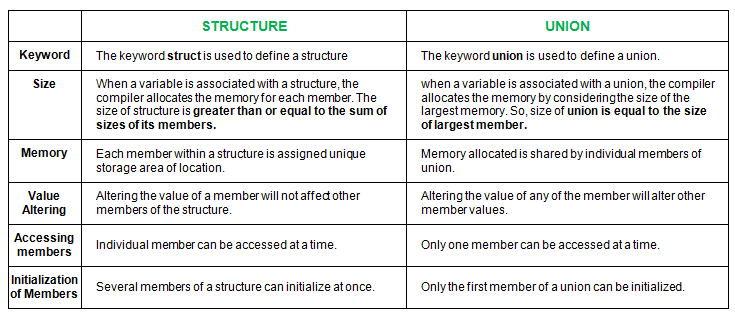The Structure is the data type that permits to combine difference between structure and union types of data items. The Union is also a data type which helps to store various data types in the same memory location. Both Structure and Union are available in C programming language. Both of these can hold any “type” of data.
Though both are user-defined container data types, there are some differences between these two data types. Are you interested to know the differences between the Structure and the Union? Of course, you’ll be. Let’s start with us.
Table of Contents
What is the Structure?
The Structure is the data-type of the C programming language. The Structure permits us to combine various types of data. If we want to construct an exact complex data type, then we can rely on the Structure.
In a structure, a single name represents different kinds of data. The common name of the variables of a Structure is ‘member’. By default, the members of a Structure are public. You can use the Structure data type to store different types of items together.
If you want to declare a Structure, you need to create a template. The template helps you to create the structure objects. The structure objects share the same member functions and the association of the data members.
You may find, the Structure is similar to an Array. The only difference is their storing characteristic. Structure stores different types of data. On the other hand, an array holds the same kinds of data only.
What is the Union?
The Union is a special kind of data type of C programming language that combines the various kinds of data to a similar storage location. Two or more types of variables share the memory space among them.
It aids us to use the same memory location for different purposes. We call the elements of a Union as ‘members’. Like the Structure, all the members of a Union are public by default. The Union data type can identify the member demands high storage. After identifying, it allocates sufficient space for its members.
The declaration of the Union data type is also similar to that of the Structure data type. A union contains many members. You can define a Union with these members. But at a particular time, only one member can provide the value. All the members of a Union possess the same storage location. To define the Union, you have to consider the Union Statement.
What are the Differences between a Structure and a Union in C Programming Language?
The Structure and the Union are similar in concepts, but they are different in the system of dealing with their storage. The Structure separately distributes the memory space for its members. On the contrary, the Union shares a similar storage location for all its members.
The distinct system of storage distribution is the significant differences between the Structure and the Union in the C programming language. Besides this vital distinction, there is also some other dissimilation between the Structure and the Union. Let’s explore the difference between Structure and Union in detail.
Storage of the Structure VS Storage of the Union:
In the case of the memory location, there is a significant difference between Structure and Union. The members of a Structure get their particular storage. Each member possesses a distinct space.
The members of a Structure get the adjacent and separate locations for them. All the members of the Structure have their particular memory place. They contain unique storage areas. It demands the allocation of space for the separate members. The Structure data type possesses a higher storage space.
On the other hand, the members of the Union do not contain separate storage. They share a shared memory space. The Union allows all its members to a single storage location. All the members of the Union have a shared memory location. The members of the Union share the storage among themselves. You can allocate the storage as per the largest member. The Union contains lower storage space than the Structure.
What are the Keywords of the Structure and the Union?
You can also differentiate the Structure and the Union based on the keyword. You can define the Structure and the Union with different types of keywords. To illustrate the Structure, you can use the keyword struct. Dot (.) operator aids you to access the Structure member. To declare the Structure, you may use the Struct keyword. The ‘struct statement’ helps to define the Structure. It represents the new data type.
The ‘struct’ always precedes the declaration of the Structure. The ‘struct’ informs the compiler about the statement of the Structure. On the other hand, if you want to define the Union, you may use the keyword’ union’. To declare the Union, you can rely on the ‘union’ keyword. It can be your perfect aid.
The Size of the Structure VS the Size of the Union:
The compiler distributes the memory among the variables of the Structure. Each member gets their particular spaces. So the size of the Structure depends on the sum of the dimensions of the members of the Structure. The size of the Structure can be equal to or greater than the summation of the sizes of the members.
The compiler also allocates the memory space to the members of the Union. In the case of the Union, there is no opportunity for separate memory allocation. So the compiler allocates the memory depending on the largest memory. It considers the largest memory to estimate the storage space to the members of the Union. The Union size depends on the size of the largest memory. The size of a Union and the largest memory of that Union are equal.
- Size of the Structure = Summation of sizes of all the members of the Structure or
- Size of the Structure > Summation of sizes of all the members of the Structure
- The Size of Union = size of the largest member of the Union
What are the Effects of Value Alteration of the Structure and the Union?
The members of the Structure possess individual memory. They have their own particular storage space. So if you alter the value of a member of a Structure, it does not affect the other members. You can change the value of one data member of the Structure. It will not change the values of other members.
But if we think about the Union, we can see all the members of the Union share the memory space among themselves. They do not possess a separate storage space. So, if you alter the value of any Union member, it will affect all the members of that Union. The values of other members of the Union will also change. In the Union, the change in the value of one data member will cause the changing of the values of all the data members.
How Can You Access the Members of the Structure and Union?
The accessing process of the members of the Structure and the Union are different because of their different types of memory allocation. We know, the members of the Structure possess their distinct memory space. As the members of the Structure have separate storage, so you can access all the members of the Structure at a single time.
On the contrary, the members of the Union share the same memory space among themselves. As they do not possess their own space, you cannot access all the members at a time. You may access only one member at the same time. In the Union, you cannot access more than one member’s values at a time.
What are the different process of Initialization of the Members of the Structure and the Union?
The distinct memory distribution also affects the initialization of the members of the Structure and the Union differently. As the members of the Structure contain their own storage space, it offers you to initialize several members at a time. The Union does not provide you the opportunity to initialize more than one member. You can initialize only the first member of the Union.
Different Usage of the Structure and the Union:
You can use the Structure and the Union for two distinct purposes. You may use the Structure to store different types of data. Y’all may use the Structure data type to gather different pieces of similar kinds of data.
It collects similar subjects of data in the same place. If you want to gather the same kinds of parameters about a large number of substances, you can rely on the Structure data types. If you use the Structure data type, you have the opportunity to use all the data types. You can use it to combine various types of data.
On the other hand, if you want to store one of the many data types, you can use the Union. With the union data type, you can ensure the efficient utilization of the memory. As all the members of the Union share the single storage, only one member can use the memory space at a time.
So, if you decide to use the Union, you can choose one data type from the data collections. When you need to access one member at a time, then you can use the Union data type.
What are the Advantages of the Structure and the Union?
Both the Structure and the Union have some distinct advantages. The Structure data type offers you access to all its members at a single time. In the Structure data type, you can use a unique name to represent data fields with different types of data.
It offers you the opportunity to represent complex information like numbers, times, etc. The structure data type is easy to maintain. You can pass the entire record to the other function with the use of a single parameter. To collect the documents of similar types, you can use the array of Structure.
The Union data type ensures the proper use of memory. Through the use of the Union data type, you can utilize the storage efficiently. All the members of the Union do not demand their own memory space. So, by allocating the shared storage for all the members, you can save memory. The Union data type only requires the space for only its largest member. The Union data type offers another opportunity for you. You can interpret the same memory space in a distinct way for different members.
Distinct Way of Viewing of the Structure and the Union:
The way of viewing the Structure and the Union are different from each other. If you are a user of the Structure data type, it will offer you a single way to observe the individual memory location. Unlike the Structure data type, the Union data type offers more the one way. The Union data type provides you various ways to view a single storage location.
Store Values and the Anonymous Features of the Structure and the Union:
The Structure data types store different values for its various members. It can allocate distinct values because of the different memory locations of the members. also, It stocks several values for the multiple members of the Structure. It Structure data type not offer any anonymous features for its users.
Unlike the Structure data type, the Union data type declares the anonymous Union. As all the members of the Union share the shared memory location, they store similar values for all the members. At a single time, the Union data type can store the same value for every member.
Example of the Structure Data Type and the Union Data Type:
A simple example can clarify the differences between the usage of the Structure data type and the Union data type. If you need to store the information about a human being, he/she is a man, a woman, or a hermaphrodite. He/she will be one of these. Only one option applies to the person. In this type of situation, you can choose the Union data type.
If you need to store the information about the preferences of the person’s food, you can choose the Structure data type. In this case, the Structure data type is applicable because the choices can be more than one.
Final Thoughts:
Both the Structure and the Union collects information. The significant differences between these two data types are how they store the information and their access method. Now, tell me, aren’t the differences between Structure and Union of C programming Language are helpful to choose the exact data type for you? Please give me your feedback about these two different data types. Till then, goodbye, guys.





